|
Further classification of Kingdom
Animalia:
The invertebrates
 Although
all the vertebrates belong basically to one phylum (Phylum Chordata),
the rest of the animal kingdom is classified into many phyla reflecting
the enormous diversity found within this group of animals without backbones
which we loosely call the Invertebrates. Although
all the vertebrates belong basically to one phylum (Phylum Chordata),
the rest of the animal kingdom is classified into many phyla reflecting
the enormous diversity found within this group of animals without backbones
which we loosely call the Invertebrates.
Sponges
Sponges are also called Phylum Porifera. The sponge's
body is a simple, asymmetrical sac with different specialised cells,
but no specific tissues or organs. They feed by filtering food from
the water through their pores into the body cavity.
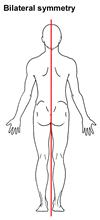 Coelenterates Coelenterates
These include jellyfish, reef corals, sea anemones (Phylum Cnidaria
or Coelenterata). They are water-dwelling, radially symmetrical animals
which have stinging cells in the tentacles around the mouth. There is
some specialisation of cells into tissues.
Worms
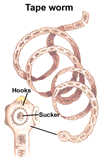 They include Flatworms, such as tapeworms (Phylum Platyhelminthes),
Roundworms (Phylum Nematoda) and Segmented worms, such as Earthworms
(Phylum Annelida). These are bilaterally symmetrical with a definite
head. They are the simplest groups with organ systems. Most live in
water but some live in soil, while others are parasites in host animals.
They include Flatworms, such as tapeworms (Phylum Platyhelminthes),
Roundworms (Phylum Nematoda) and Segmented worms, such as Earthworms
(Phylum Annelida). These are bilaterally symmetrical with a definite
head. They are the simplest groups with organ systems. Most live in
water but some live in soil, while others are parasites in host animals.
Molluscs
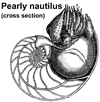 Molluscs include squid, bivalve shells, snails and slugs (Phylum Mollusca).
The molluscs are mainly marine dwellers, though snails and slugs live
on land. They are bilaterally symmetrical. They have a soft body, muscular
foot, well-developed body systems and often secrete a hard shell.
Molluscs include squid, bivalve shells, snails and slugs (Phylum Mollusca).
The molluscs are mainly marine dwellers, though snails and slugs live
on land. They are bilaterally symmetrical. They have a soft body, muscular
foot, well-developed body systems and often secrete a hard shell.
Echinoderms
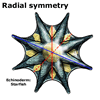 These
are starfish, sea urchins and sea cucumbers (Phylum Echinodermata).
These are all marine, radially symmetrical organisms with sucker-like
tube feet and an internal lime skeleton. These
are starfish, sea urchins and sea cucumbers (Phylum Echinodermata).
These are all marine, radially symmetrical organisms with sucker-like
tube feet and an internal lime skeleton.
Arthropods
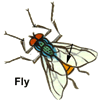 These
include crustaceans, spiders, centipedes and insects (Phylum Arthropoda).
This is the largest animal phylum with more than a million species. These
include crustaceans, spiders, centipedes and insects (Phylum Arthropoda).
This is the largest animal phylum with more than a million species.
These have a hard external skeleton with jointed appendages (spiders
have eight legs, insects have six). Body is usually segmented into head,
thorax and abdomen. They have successfully colonised all habitats, marine,
freshwater, and terrestrial.
 The
main classes of arthropods are: The
main classes of arthropods are:
- Crustaceans e.g. crab, crayfish, shrimp.
- Insects e.g. fly, ant, butterfly, dragonfly,
mosquito.

- Arachnids e.g. spiders

- Myriapods e.g. centipedes and millipedes.

|